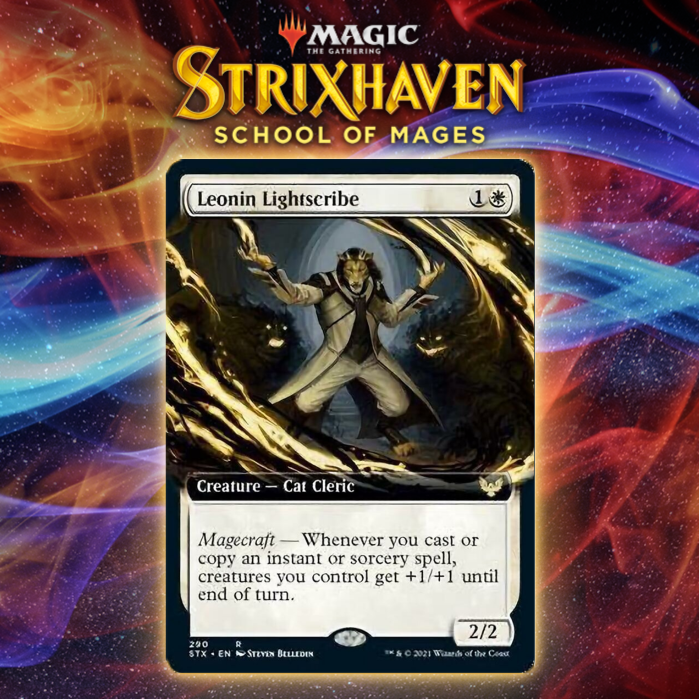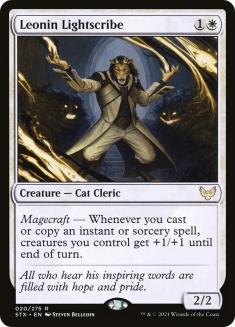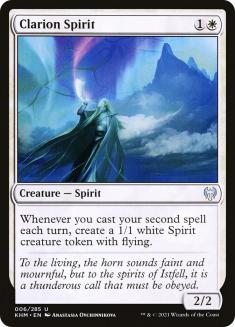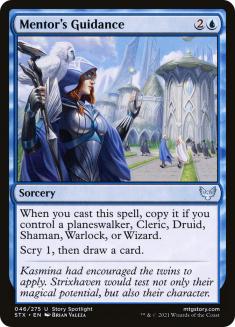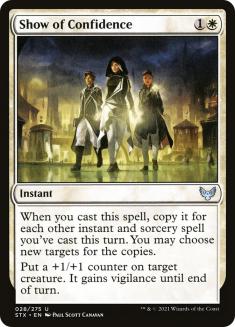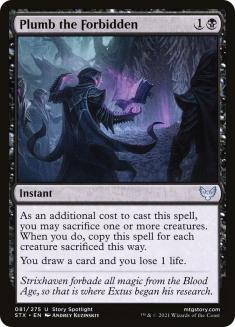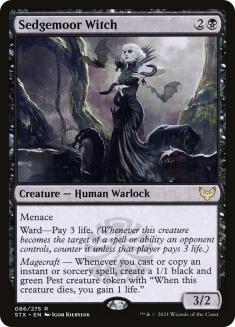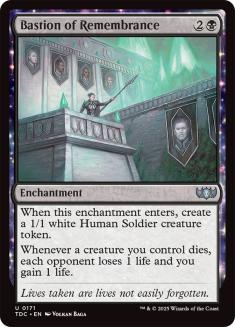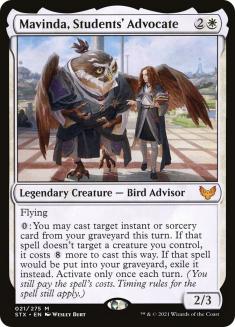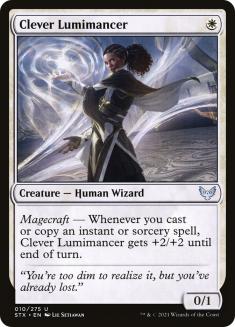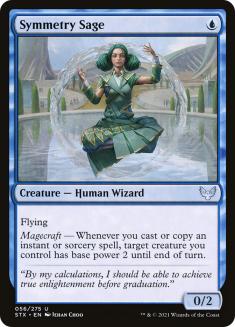Leonin Lightscribe offers multiplicative damage, making it the magecraft card with the highest ceiling, which is always a great place to start when exploring a new mechanic. It offers a bit of a deckbuilding challenge to maximize your returns, since you need a density of both creatures and instants or sorceries, but that seems like a manageable challenge; after all, most decks want creatures and spells.
We could just play it in a regular deck with a mix of creatures and cheap interactive spells, where any time it’s on the battlefield, the opponent won’t necessarily know how large our creatures can be in combat. If we can average one spell per turn, this is a pretty good creature, being something like a lord that doesn’t care about creature types, but most normal creature decks looking for a lord likely will cast substantially fewer than one instant or sorcery per turn, so we want to find ways to do better than the baseline.
The first observation is that we can lean on Adventure creatures — this always seems to be the solution to whatever question we’re presented with. That way, a single card can give us both a creature and an instant or sorcery, though not necessarily in the perfect order. This is a pretty good start, but not really any better than a spell that makes token creatures.
Speaking of, if we have any of those, that would be great, and regardless of whether we can use instants or sorceries to make tokens, we’ll probably get more value out of Leonin Lightscribe if we can make tokens somehow so that we can get more than one creature per card we cast. Clarion Spirit is a great starting point here.
We would also love cheap spells that draw cards, as those are the easiest ways to generate extra triggers, but the most explosive option would probably be cards that copy themselves.
In Standard, there are a few notable cards that copy themselves: Banish into Fable, Mentor’s Guidance, Plumb the Forbidden, and Show of Confidence. Banish into Fable is tricky to use here, as it costs a lot of mana and requires a lot of cards that aren’t creatures, instants, or sorceries.
Mentor’s Guidance is very simple — if we have Leonin Lightscribe, it will trigger twice and we’ll draw two cards. This isn’t bad, but I’m not sure how well blue supports a wide or aggressive deck, though we could play this and Opt with Clever Lumimancer and Leonin Lightscribe, and maybe that’s a reasonable start.
Show of Confidence is explosive, but very hard to use. If we can cast two spells and then Show of Confidence with a Leonin Lightscribe on the battlefield, all our creatures will get +5/+5, but that sounds fairly difficult to set up.
I’m most excited about Plumb the Forbidden. The “default” application is probably a two-mana Village Rites (or an Altar’s Reap if you prefer) that costs two life, but used that way, it also triggers magecraft twice. This creates a weird dynamic where the more creatures we sacrifice, the more we pump our team. But if we imagine that we have five 1/1s and Leonin Lightscribe, if we sacrifice two of them, our remaining four creatures each get +3/+3 and we draw three cards, so now we’re attacking for seventeen instead of seven, and we can do that in combat after blocks, so we can sacrifice creatures that were blocked.
Okay, so that’s kind of powerful, but how are we getting those creatures in the first place? Great question! Maybe I can give my answer in the form of a decklist.
Creatures (20)
Lands (20)
Spells (20)
Sideboard

This deck uses Clarion Spirit and Sedgemoor Witch to make tokens with Leonin Lightscribe to pump them up. Selfless Savior gives you a one-mana creature that can protect your engines, while Faerie Guidemother offers a one-mana creature and/or magecraft trigger. Defiant Strike and Cling to Dust are cheap cantrips, and Village Rites and Plumb the Forbidden dig further to let you keep casting spells. It’s a little weird to keep sacrificing creatures while we’re trying to go wide, but Sedgemoor Witch is a powerful engine.
If we have Sedgemoor Witch and Plumb the Forbidden, we can sacrifice all of our Pests and immediately recoup the life and replace the tokens. If we get multiple Witches on the battlefield, this doubles our Pests while drawing cards, possibly to find another Plumb the Forbidden.
Duress offers a cheap magecraft trigger that protects our important creatures and Vanishing Verse is a cheap, versatile removal spell. The sideboard allows us to lean further into discard with Humiliate, or add removal with Swallow Whole and Heartless Act. If Sedgemoor Witch is weak in the matchup, we can cut it to enable Lurrus as a companion.
I didn’t include Bastion of Remembrance, but that could be a mistake. It might be the missing piece to maximize an engine that’s all about making and sacrificing tokens, but that feels like a slightly different direction, and I’m not sure if it would want Leonin Lightscribe.
The next thing I want to investigate is whether maybe we can use Show of Confidence since we do have a lot of cheap cantrips.
Creatures (30)
- 4 Lovestruck Beast
- 4 Faerie Guidemother
- 4 Edgewall Innkeeper
- 2 Jolrael, Mwonvuli Recluse
- 2 Toski, Bearer of Secrets
- 4 Clarion Spirit
- 4 Jaspera Sentinel
- 4 Leonin Lightscribe
- 2 Mavinda, Students' Advocate
Lands (20)
Spells (10)
Sideboard

Is it worth playing cantrips to trigger Leonine Lightscribe and Show of Confidence? Well, they make Clarion Spirit and Jolrael trigger a lot more often, and giving Lovestruck Beast trample is fairly strong. Cantrips like this can definitely lead to clunky draws, but I wouldn’t rule out the possibility that it’s worth it.
Mavinda, Students’ Advocate is cool here, since we have eight cantrips that target our own creatures, and it can also recast Show of Confidence. Primal Might out of the sideboard is another way to get value out of it.
This version only plays eight Adventure creatures in the maindeck to go with Edgewall Innkeeper, but the cantrips should make the synergies come together more often.
Last on the list of self-copying spells, we had Mentor’s Guidance. Can we make that work?
Creatures (20)
Lands (20)
Spells (20)
Sideboard

Clever Lumimancer requires a lot of dedication, since it has no power unless you’re casting spells, but I think the density of cantrips in this deck allows us to take advantage of it.
Symmetry Sage works well with Clever Lumimancer, since the second time you trigger Symmetry Sage you can add two additional power to your Lumimancer, and Luminarch Aspirant appreciates the flying creature to put counters on. The cantrip density in this deck makes it easy to find multiple copies of Frantic Inventory to make the most of all three of our magecraft creatures.
This deck reminds me of Azorius Heroic, but for the most part, you don’t have to target your creatures. This is a bunch of fairly small blue and white creatures in a shell that can lead to explosive attacks or grinding your opponent out with card advantage from Mentor’s Guidance and Frantic Inventory if they’re spending their time answering your threats.
How does this deck line up with or play against other decks in Standard? I’m not entirely sure. The hope is that the creatures are explosive / synergistic enough to compete with aggressive creature decks, and the counterspells plus pressure should be good against Sultai Ramp (Yorion), but I always need some experience to see how smooth decks with this many cantrips end up being.
What about red? Does red offer anything to work with here? Absolutely!
Creatures (24)
- 4 Robber of the Rich
- 4 Bonecrusher Giant
- 4 Magmatic Channeler
- 4 Stonebinder's Familiar
- 4 Clever Lumimancer
- 4 Leonin Lightscribe
Lands (20)
Spells (16)

There are a lot of different angles you can focus on here. Stonebinder’s Familiar is really interesting in Boros, where it’s easily triggered with an extremely wide range of cards you want to play anyway — Robber of the Rich, Magmatic Channeler, Skyclave Apparition, any Adventure spell, most white removal, Elite Spellbinder, any escaping — it’s incredibly easy to reliably put cards in exile.
Satyr’s Cunning and Forbidden Friendship offer efficient spells that make tokens, which do double duty with Leonin Lightscribe, and of course you can lean further into Adventure creatures for more triggers, with cheap options like Rimrock Knight in addition to the white cards we’ve already been using. If we really wanted to maximize Leonin Lightscribe, we could play Rimrock Knight, possibly paired with Magda, Brazen Outlaw for more explosive turns, instead of cards like Robber of the Rich that are enabling Stonebinder’s Familiar.
If we could lean more red-heavy, we could make good use of Birgi, God of Storytelling to help chain spells together, but Crash Through is the only one-mana red cantrip. We could still use it for a discount on Thrilling Discovery, which is a nice upgrade to Cathartic Reunion since we don’t have to discard if it’s countered and we can cast it for a trigger even if we don’t have cards to discard (to say nothing of the two life).
The spell density in this deck really makes Magmatic Channeler shine. It would be nice if we could play Shatterskull Smashing and Emeria’s Call so that they could be spells when we discard them, but it’s too important to maximize Furycalm Snarl.
One direction I haven’t explored is using cards with learn to generate additional magecraft triggers, which they can reliably do. The issue is that the Lessons are… not great. It’s kind of cute that we could potentially play Hunt for Specimens into Pest Summoning to get three Pests and two magecraft triggers for five mana, but that’s not a particularly good rate, and I don’t know that we can really do all that much better than that.
It’s just really hard to use Lessons particularly aggressively since they’re so expensive. I could maybe imagine using this pair with Sedgemoor Witch, Bastion of Remembrance, and Plumb the Forbidden, but I’m not sure Leonin Lightscribe would be better than Witherbloom Apprentice in such a shell.

